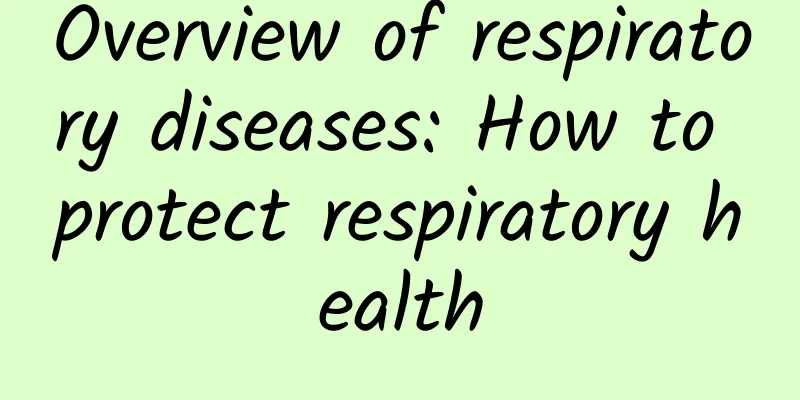Overview of respiratory diseases: How to protect respiratory health

|
In daily life, we often encounter physiological symptoms such as dyspnea, cough, asthma, and itchy throat, which may be related to respiratory diseases. Respiratory diseases refer to diseases that affect the respiratory system, including diseases of the nasal cavity, throat, trachea, bronchi, and lungs. These diseases are caused by infection, allergies, environmental factors, genetics, and other reasons. With the intensification of environmental pollution and changes in lifestyle, the incidence of these diseases has continued to rise, becoming a health problem that cannot be ignored in daily life. How to protect the health of the respiratory system? In fact, you only need to pay attention to some small details to greatly reduce the risk of respiratory diseases. Here we introduce some simple and easy methods to help you protect the health of your respiratory system and stay away from the troubles of respiratory diseases. 1. Common respiratory diseases First, let us take a look at some common respiratory diseases: 1. Cold: A cold is a respiratory disease caused by a viral infection. Common symptoms include sneezing, runny nose, sore throat and cough. 2. Asthma: Asthma is a chronic inflammatory disease characterized by limited airflow in the respiratory tract, causing symptoms such as dyspnea, coughing and wheezing. During an asthma attack, the respiratory tract will experience brief contraction and spasm, leading to dyspnea. 3. Chronic obstructive pulmonary disease (COPD): COPD is a group of chronic inflammatory lung diseases, including chronic bronchitis and emphysema. The main symptoms are dyspnea, cough and sputum. COPD is usually related to smoking. In addition, long-term exposure to harmful gases and dust may also cause the disease. 4. Pneumonia: Pneumonia is an infectious disease of the lungs, often caused by bacteria, viruses or fungi. Symptoms of pneumonia include difficulty breathing, fever, cough and chest pain. 5. Lung cancer: Lung cancer is one of the most common malignant tumors. It is mainly caused by smoking, but can also be caused by other factors such as environmental pollution or genetic factors. There may be no obvious symptoms in the early stages of lung cancer, but in the late stages, coughing, coughing up blood, difficulty breathing, chest pain and weight loss may occur. In addition to these common respiratory diseases, there are other rare but important diseases, such as pulmonary hypertension and fibrotic lung disease. Diagnosis and treatment require a doctor's evaluation, examination and monitoring. If you have any related questions or need to know more about the specific disease, you need to consult a doctor to obtain an accurate diagnosis and treatment recommendations. 2. How to protect respiratory health The following discusses how to protect respiratory health for common respiratory diseases. 1. Maintain good hygiene habits: wash your hands frequently, especially after being in places or doing activities that expose you to viruses and bacteria, and avoid touching your face, especially your eyes, nose, and mouth, to reduce the chance of viruses and bacteria entering your respiratory tract. 2. Pay attention to a balanced diet: ensure adequate intake of vitamins and minerals, especially vitamin C and zinc, to enhance immunity, and eat more foods rich in antioxidants, such as fruits, vegetables and nuts, to reduce the risk of respiratory diseases. 3. Quit smoking and avoid secondhand smoke: Smoking is one of the main factors leading to respiratory diseases. The harmful substances in tobacco smoke can damage the lungs' defense mechanism and increase the risk of lung cancer, chronic obstructive pulmonary disease, bronchitis and other diseases. We have emphasized the harm of smoking, but we also need to pay attention to the threat of secondhand smoke. As long as there are people smoking around us, we may be harmed by secondhand smoke. The harmful substances in secondhand smoke can also enter our respiratory tract and damage the health of the lungs and respiratory system. Therefore, try to avoid staying near smokers to ensure the respiratory health of yourself and your family. 4. Exercise regularly and maintain a healthy weight: Moderate exercise can enhance the function and elasticity of the respiratory system and help clear the lungs of accumulation. In addition, maintaining a healthy weight and avoiding excessive obesity can reduce the respiratory burden and reduce the risk of chronic respiratory diseases. 5. Keep the indoor air fresh: Indoor humidity and mold can lead to respiratory infections and asthma. Keeping the indoor air circulating, cleaning and dehumidifying regularly, and using an air purifier to filter pollutants in the air can help keep your respiratory tract healthy. 6. Avoid exposure to air pollutants: Air pollutants, such as particulate matter, automobile exhaust and industrial waste gas, can cause serious damage to the respiratory system. Try to avoid staying in a highly polluted environment for too long, and wear a mask when going out to filter out harmful particles in the air. 7. Regular physical examinations and immunizations: Regular physical examinations can detect signs of early respiratory diseases and take treatment measures as early as possible. At the same time, receiving appropriate immunizations, such as influenza vaccines and pneumonia vaccines, can effectively prevent some respiratory diseases. Protecting your respiratory health is protecting your life and health! We should always keep in mind the prevention of respiratory diseases and take corresponding actions. In this article, we provide some simple and effective methods to help you prevent the occurrence of respiratory diseases. The above opinions are only personal. It is recommended to consult a doctor before taking specific actions. If symptoms related to respiratory diseases occur, it is recommended to seek medical attention in time and receive professional diagnosis and treatment. (Wang Lu, Lingshou County People's Hospital, Shijiazhuang City, Hebei Province) |
<<: You have to know these things when you have an MRI
>>: What are the dangers of long-term indigestion to health and how to prevent it?
Recommend
Can Down's Syndrome be cured?
Can Down syndrome be cured? Down syndrome is a se...
Treatment methods for vulvar atrophy, treatment and care should be done well
Vulvar atrophy is common among middle-aged women....
What to do if you get pregnant unexpectedly after having an IUD inserted
Nowadays, no contraceptive method is 100% success...
Mole on labia
In fact, few people will carefully observe their ...
Pregnant mothers' small class | When you encounter asthma during pregnancy, you must know these "medicines"...
Nurturing a life is such a wonderful thing, but f...
What should pregnant women do if their stomachs get cold?
Pregnant women should always pay attention to cha...
Can I eat watermelon after a caesarean section?
Cesarean section itself will cause certain physic...
Are uterine fibroids contagious?
Modern people have an increasingly stronger aware...
When frying small fish, should I coat it with flour or eggs first? What is better for frying small fish?
We all know that fried fish is a common delicacy....
What is the reason for the discharge of black blood clots after medical abortion?
Medical abortion is a relatively common method of...
Will your skin really become darker if you eat too much soy sauce?
Hello, this is Science Popularization China. What...
What can I eat to enlarge my breasts after miscarriage?
Women are very eager to have proud breasts. But t...
Why is it so hot during the dog days? Can you swim during the dog days?
The dog days are hot mainly because they are the ...
What is the reason for the pain in the right hip bone?
Pain in the right hip of women is a problem that ...









![[Fat Bear Science] @Women! Are women with large breasts more likely to get breast cancer? Can men get breast cancer? You must know these 7 questions](/upload/images/67f1ebee42e80.webp)